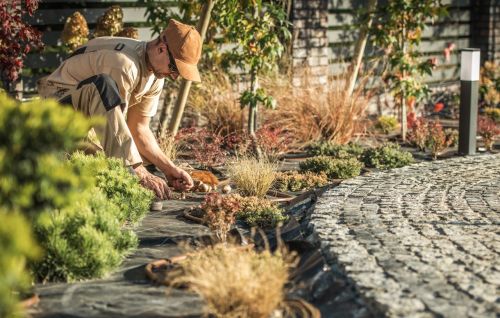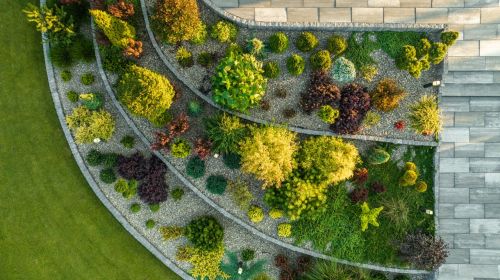If you're dreaming of a green, vibrant, and well-kept garden, grass is one of the first things that comes to mind. But achieving that flawless look requires proper technique when planting grass seed. So, how to plant grass in the garden, when is the best time, and how long does it take for grass to grow? Here's your complete lawn planting guide!

Lawn grass refers to a dense and green plant cover made up of perennial herbaceous species that grow tightly packed. When trimmed regularly, it takes on an aesthetically pleasing form and is widely used for both decorative and functional purposes in landscaping projects, home gardens, parks, and public spaces. In addition to providing a sense of natural beauty and a clean, well-maintained appearance, grass offers several important environmental benefits.
One of the most notable advantages of using lawn grass in gardens is its ability to prevent soil erosion. It protects the soil surface against the damaging effects of wind and water by holding it in place. During hot summer months, grassy areas reduce ambient temperature significantly compared to bare soil or concrete surfaces, creating a naturally cooler environment. Lawn grass also acts as a dust filter, improving air quality by trapping airborne particles. From a visual perspective, green-dominated spaces promote a sense of peace, freshness, and mental relaxation.
The question “When should grass be planted?” depends on the climate characteristics of your region, but generally, the most suitable periods for sowing grass are spring and autumn. Specifically, the months from March to May and from September to October offer ideal conditions in terms of soil temperature and humidity levels. During these seasons, the balance between sunlight, warmth, and soil moisture allows grass seeds to germinate and grow healthily. If you plan to sow grass during the summer, a carefully planned irrigation schedule is essential to prevent drying and ensure successful growth.
To establish a successful lawn in your garden, certain basic materials are required:
Grass seeds appropriate for your climate and intended use
Garden soil enriched with organic matter
Tools such as a rake and hoe for soil preparation
Lawn roller (to level and compact the soil)
Garden hose or automated irrigation systems
Choosing high-quality seeds suited to your region is the first step. The soil should be rich in organic material to provide essential nutrients. During the preparation process, you'll need tools like a rake or hoe to break up the soil and a roller to level the surface. Consistent and efficient watering is also critical, especially in the germination phase, so proper irrigation systems should be in place.
Soil preparation is the most critical step before planting. The designated area should be cleared of rocks, weeds, and debris. The soil should be dug and loosened to a depth of 15–20 cm to improve aeration and root development. If the soil lacks nutrients, it should be enriched with compost or peat. A slight slope can be added to the surface to ensure proper drainage, followed by compacting the soil using a roller to achieve a smooth and level base.
Seed selection is a key factor in achieving a healthy and visually appealing lawn. Factors such as sunlight exposure, intended use, and local climate will affect your choice. For shaded areas, Festuca rubra is recommended. In warm, sunny climates, Bermuda grass performs well. For those who want rapid germination, Lolium perenne is an excellent option.
Spread the seeds evenly over the prepared soil either by hand or with a mechanical spreader. Lightly rake the surface to ensure good contact between the seeds and the soil. To prevent the seeds from drying out and to support germination, apply a thin layer of fine peat or sifted topsoil. Finally, use a lawn roller to firmly press the seeds into the soil for better contact and root anchoring.
After sowing, water the soil immediately. This first watering is vital to kick-start the germination process. For the first 2–3 weeks, the soil surface should be kept consistently moist, requiring irrigation once or twice a day depending on weather conditions. Both overwatering and letting the soil dry out can harm the seeds. Early morning and late afternoon are ideal times for watering.
The germination time for grass depends on the seed type, weather conditions, soil quality, and watering frequency. In general, grass begins to sprout within 7 to 21 days after sowing. Fast-germinating species like Lolium perenne may begin to grow in 7–10 days, while other varieties can take 15–20 days. The first mowing should be done once the grass reaches a height of 8–10 cm. At this stage, the blades should not be cut too short to avoid damaging the young lawn.
Maintaining your lawn after planting is just as important as the sowing process. Consistent care ensures long-term health and aesthetics. Here are the key maintenance practices:
Mowing: The first mowing should be done at a higher blade setting. Gradually lower the cutting height over time, but avoid mowing the grass too short as it may stress the plant.
Fertilization: About 4–6 weeks after sowing, apply a nitrogen-rich lawn fertilizer to support healthy growth.
Aeration: Over time, soil compaction may prevent water and air from reaching the roots. Aerate the soil once or twice a year using appropriate tools.
Weed Control: Prevent weeds from overtaking the lawn by removing them manually or using selective herbicides that won’t harm the grass.
Planting grass in your garden can result in a lush, long-lasting green space—if done with proper timing, quality seeds, and consistent care. With well-prepared soil, the right grass seed, and routine maintenance, your garden can transform into a beautiful, natural carpet that enhances your outdoor living area.
For expert guidance, grass seed varieties, and all lawn care solutions, Cem Botanik is always here to help!





